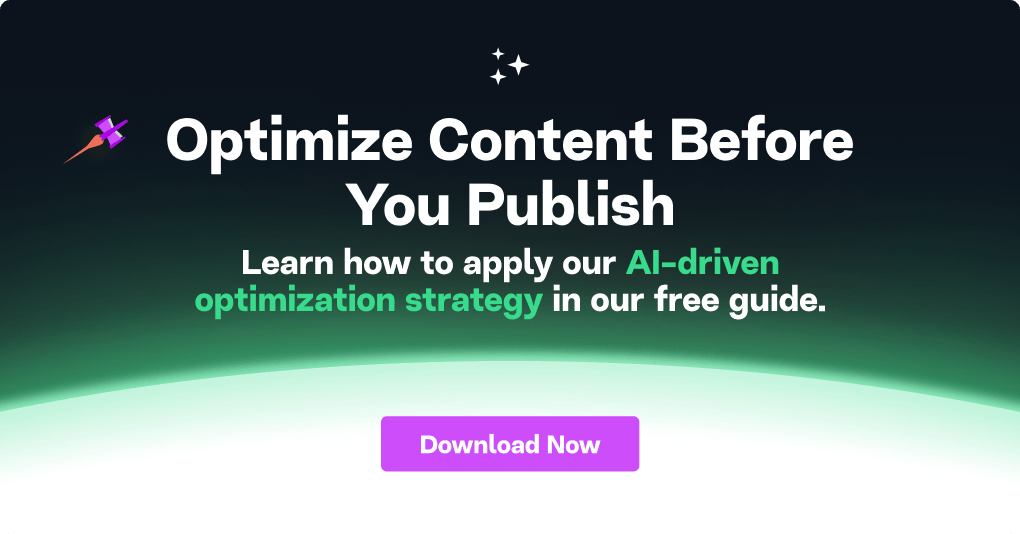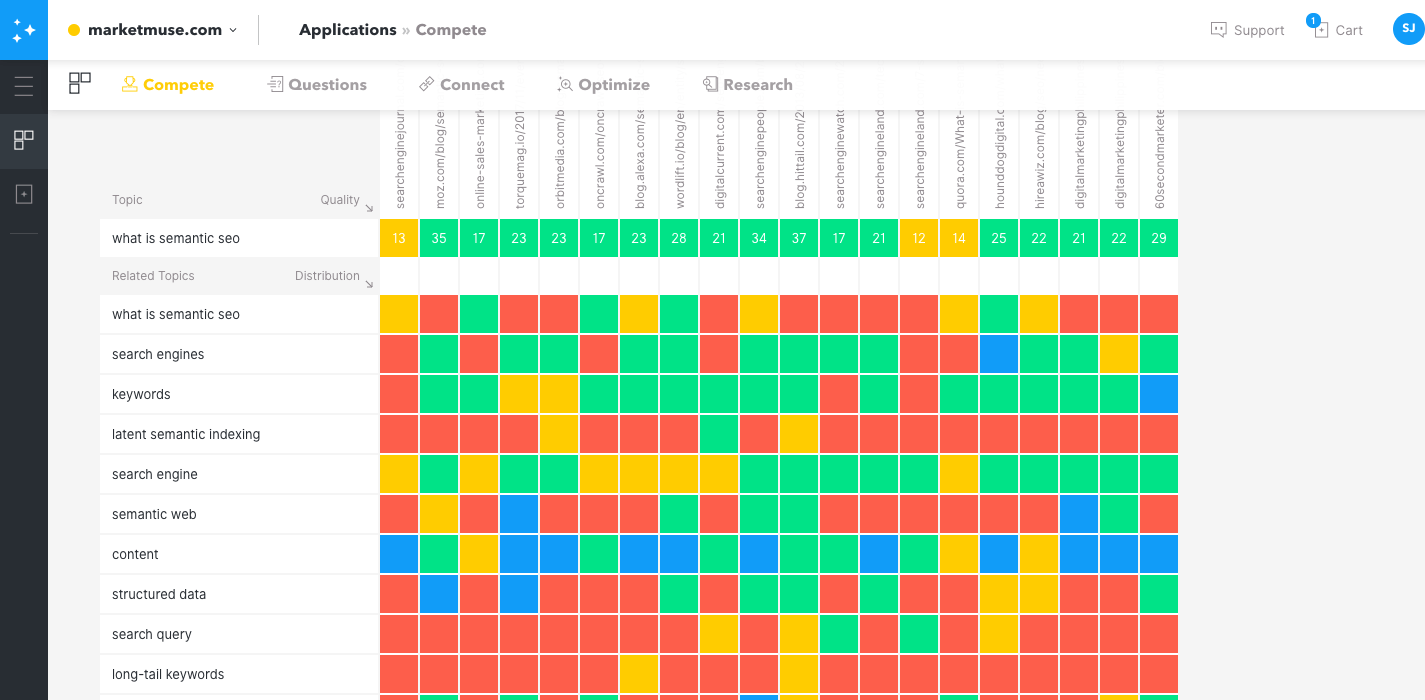How to Optimize Content for Semantic SEO
Just when you think you’ve got this search engine optimization stuff figured out, someone comes along with yet another new term: semantic SEO.
Once upon a time, SEO was much simpler. Pick a keyword phrase, use it in your title, subheaders and throughout the post. But all that changed with the introduction of RankBrain in late 2015.
Suddenly, Google is a semantic search engine. It can understand the content on a page and match it to search intent. Searchers have questions, and Google connects them to the most relevant content that answers that search query.
What Is Semantic SEO?
Topic is the new keyword.
Semantic SEO is about topics and their relationships. It’s about satisfying the search intent of your visitors.
The goal of semantic SEO is to provide relevant content that unambiguously answers a specific user intent. Simple to say, but not as easy to accomplish. But to rank well in the SERPs, this is what you need to do.

How Semantic SEO Impacts the Content Creation Process
Using keywords tools for semantic SEO is like bringing a knife to a gun fight. I should know. I used to be in that position. In this post, we look at two approaches to the SEO strategy of creating high-quality content.
One method uses MarketMuse Suite, which leverages artificial intelligence and natural language processing to create an accurate knowledge graph of any topic quickly. It took me literally less than five minutes to accomplish these four steps using MarketMuse Suite. Content optimization workflows like this scale easily.

The other method relies on tools that are either free or inexpensive, but require significantly more time to produce results that aren’t necessarily equal in quality.
To be clear, when writing for the semantic web, think beyond keywords and start focusing on topics.
Before setting the proverbial pen to paper, you should:
- Research the most important subtopics to incorporate into your content that will improve ranking
- Analyze the competition to determine where they suffer from content gaps
- Find and answer the most important questions your audience is asking
- Determine the best internal links that will help readers and search engines
Optimizing Content for Semantic SEO
So let’s get started with this four-step process!
Research Semantically Related Topics
To create my list, I used the MarketMuse Research app which took 42 seconds. This screenshot shows a partial list of related topics along with their suggested distribution and variants. This post on writing SEO optimized content goes into more detail on each of these apps.

Pay attention to the those related topics that MarketMuse presents. They provide a good picture of what’s necessary in order to cover that topic comprehensively. That will be important later on.
Here are some other alternatives to MarketMuse.
Type your topic into Google, and it provides a list of related searches. Grab these phrases and copy them into your notepad. You’ll need them later.
Oh wait, it’s not that easy.
Try KeywordTool.io instead. It suggests the same phrases as Google except it allows exporting of results directly into a spreadsheet or notepad.
But there’s another problem.
So far, these alternatives aren’t providing much detail on the topic. It’s really a list of some search queries related to the issue of semantic SEO. Unfortunately, it doesn’t give us a great deal of insight into what we need to do to create an in-depth blog post.
Let’s try LSIgraph.
This software tool uses latent semantic indexing (LSI) to produce a set of related keywords. Topic modeling has drastically improved since LSI was patented in the late 1980’s. Although popular with a certain segment of the SEO crowd, you can be sure that Google is using a more robust way of modeling that doesn’t suffer from those limitations.

Add these to your list of topics to discuss in your post. Note that the LSI keywords for this topic, for the most part, are variations. They either have “SEO” or “semantic” contained in the phrase.
It’s not the best, but it’s free.
You’ll find the similarity in those keywords a challenge when creating an article that is in-depth. There’s just not enough topic breadth to create something of high quality.
Analyze Content Gaps in The Competition
It took a total of 40 seconds to analyze the competition and discover their content gaps using MarketMuse.

Determining content gaps is critical to ranking well. But it’s incredibly time-consuming to do this manually.
How to Create Great Content That Ranks covers this in more detail.
But be warned. It takes hours instead of seconds to get this done.
You need to manually review at least the top ten competitive pages and make a list of all the topics covered by each one. Record this in a spreadsheet and apply some conditional formatting to make the gaps visually easy to discern.
Find The Questions
Answering the questions your readers ask helps ensure your content satisfies search intent. But first, you have to find those questions.
It took MarketMuse a full 90 seconds to come up with a list of questions that you can see below in this partial screenshot.

These are questions that competing content has addressed within their posts. So it’s a good idea to answer these questions within yours.
A free alternative is Answer The Public. Like many free tools, this one relies on Google autocomplete to create its unique mapping of questions.

You’ll notice that the number of questions is minimal. That’s even after I modified the topic slightly in an attempt to get better results.
This tool also offers some suggestions for long-tail keywords. However, the relationship to the topic of “semantic SEO” is straightforward. All the suggestions contain those two words, nothing more.
That indicates a simple knowledge graph on the part of this tool. Although it can generate some questions and key phrases, the relationship to the main focus topic is limited.
Another option is to read through the top 10 ranking pages to discover the relevant questions that each page addresses.
Long discovery process? You bet!
But if you don’t have MarketMuse and the free tools aren’t cutting it, you have little choice. Search engine optimization is no longer about using hacks. It’s about creating value.
Find those questions that people are asking. Answer them completely and concisely, and the search engines will love you for it. Read this guide to content optimization for additional insight.
Determine The Best Internal Links
In 95 seconds MarketMuse returned a couple of dozen link suggestions with matching anchor text relevant to this post. Is there another way to do this?
Yes, but you’ll be counting minutes as opposed to seconds. Here’s what you need to do.
Review all the relevant subtopics you discovered in step one. Identify a handful of the most important ones and conduct a site search on Google. Its search algorithm will return what it considers the most relevant results.
Here’s one for “SEO infographic.”

You’ll need to repeat this process for each anchor text you plan on using. Linking to these posts using semantic keywords helps search engines understand the relationship between different posts within the cluster.
Start Now
On-page SEO optimization has become more complicated in the age of semantic SEO. Keyword stuffing no longer helps content rank in organic search. To do well, focus on covering all related topics in-depth, providing concise answers to the questions asked, and filling the content gaps in competitive pages.
You can do this manually if you insist, but it’s way too much work. And it will never scale.
One last thing. Everything we’ve talked about goes beyond creating articles and web pages. You can use topic modeling during a site redesign stage as it’s a perfect opportunity to gain SEO wins.
Feature image credit designed by Freepik
What you should do now
When you’re ready… here are 3 ways we can help you publish better content, faster:
- Book time with MarketMuse Schedule a live demo with one of our strategists to see how MarketMuse can help your team reach their content goals.
- If you’d like to learn how to create better content faster, visit our blog. It’s full of resources to help scale content.
- If you know another marketer who’d enjoy reading this page, share it with them via email, LinkedIn, Twitter, or Facebook.
Stephen leads the content strategy blog for MarketMuse, an AI-powered Content Intelligence and Strategy Platform. You can connect with him on social or his personal blog.